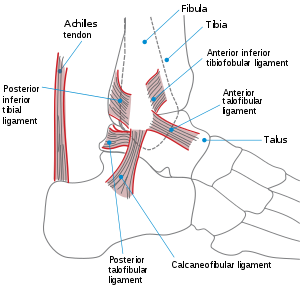Sprained ankle
| Sprained ankle | |
|---|---|
 |
|
| Lateral view of the human ankle | |
| Classification and external resources | |
| Specialty | Orthopedics, sports medicine |
| ICD-10 | S93.4 |
| ICD-9-CM | 845.00 |
| DiseasesDB | 726 |
| MedlinePlus | 003167 |
| eMedicine | topic list |
A sprained ankle, also known as an ankle sprain, twisted ankle, rolled ankle, floppy ankle, or just ankle injury, is a common injury where sprain occur on one or more ligaments of the ankle.
Knowing the symptoms that can be experienced with a sprain is important in determining that the injury is not really a break in the bone. When a sprain occurs, blood vessels will leak fluid into the tissue that surrounds the joint. White blood cells responsible for inflammation migrate to the area, and blood flow increases as well. Along with this inflammation, swelling from the fluid and pain is experienced. The nerves in the area become more sensitive when the injury is suffered, so pain is felt as throbbing and will worsen if there is pressure placed on the area. Warmth and redness are also seen as blood flow is increased. Also present is a decreased ability to move the joint, and difficulty using the affected leg.
Right foot, housed in an air brace, has become swollen as a result of a more severe 2nd degree sprain to the ankle.
Right foot. A light 2nd degree sprain, two days after injury.
Right foot, 3rd degree sprain. One day after injury.
Movements - especially twisting, turning, and rolling of the foot - are the primary cause of an ankle sprain.
The risk of a sprain is greatest during activities that involve explosive side-to-side motion, such as squash, tennis or basketball. Sprained ankles can also occur during normal daily activities such as stepping off a curb or slipping on ice. Returning to activity before the ligaments have fully healed may cause them to heal in a stretched position, resulting in less stability at the ankle joint. This can lead to a condition known as Chronic Ankle Instability (CAI), and an increased risk of ankle sprains.
The following factors can contribute to an increased risk of ankle sprains:
Ankle sprains occur usually through excessive stress on the ligaments of the ankle. This can be caused by excessive external rotation, inversion or eversion of the foot caused by an external force. When the foot is moved past its range of motion, the excess stress puts a strain on the ligaments. If the strain is great enough to the ligaments past the yield point, then the ligament becomes damaged, or sprained.
Ankle sprains are classified grade 1, 2, and 3. Depending on the amount of damage or the number of ligaments that are damaged, each sprain is classified from mild to severe. A grade 1 sprain is defined as mild damage to a ligament or ligaments without instability of the affected joint. A grade 2 sprain is considered a partial tear to the ligament, in which it is stretched to the point that it becomes loose. A grade 3 sprain is a complete tear of a ligament, causing instability in the affected joint. Bruising may occur around the ankle.
...
Wikipedia
